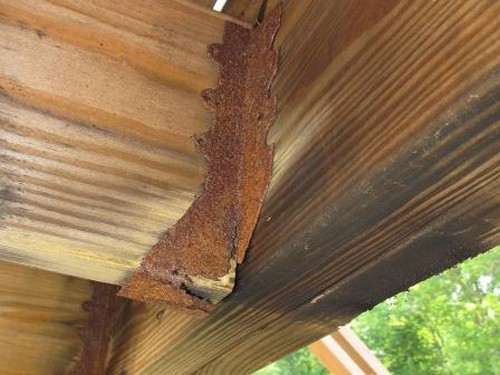If it seems like you hear more news stories about collapsing decks, it’s not just your imagination. According to the North American Deck and Railing Association (NADRA), approximately 40 million decks are over 20 years old, and this greatly increases the likelihood of the deck failing.
As you gear up for more time outdoors, now is the time to inspect your deck to ensure it’s safe for everyone to use. These are the 7 signs of a dangerous deck:
1. Loose Connections – If any part of your deck that should be stationary (such as railing) now wobbles, this is a sign of a failing connection. If you feel the deck give way or creak loudly when you step on it, step off immediately and do not use it as this is a sign of failing structure.
2. Missing Pieces – If any pieces of the stairs, railings or flooring are missing, they need to be replaced before using the deck. Analyzing why the piece failed in the first place may lead to a bigger issue that needs to be addressed. Look under the deck to ensure that all joists are still in place and all connections are still tightly intact.
3. Metal Corrosion – Metal pieces on your deck include joists, screws and flashing. If any of these shows signs of rust or corrosion, this can indicate water damage that undermines structural integrity. Before replacing the failing piece inspect the area around it for soundness, and that fasteners specifically for treated lumber are used.
4. Wood Rot & Warping – If any wood on your deck is cracking, splitting or fraying, these are notorious signs of water damage. If boards that are supposed to be straight now have a noticeable sway or curve to them, this is a sign of warping. In both cases, the wood has begun to decay and its structural integrity has been compromised and needs to be replaced.
5. Nails Instead of Screws & Fasteners – If you only see nail heads connecting the pieces of your deck, this is a deck built before codes were updated. Most deck building codes now require screws, metal joist hangers and increased connection to the house itself. If there’s any doubt about how it’s fastened, do not use the deck until it’s been inspected for structural safety.
6. Posts Off-Center of Footings – Vertical deck posts need to rest roughly in the center of their appropriately-sized concrete footings. If the posts have moved or portions hang off the surface of the footing, this indicates a potentially dangerous structural shift. If you have no footings at all (similar to the photo above), the deck was built incorrectly and cannot be trusted to keep your family safe.
7. Posts in Contact with Concrete or Dirt – A vertical deck post needs to end in a metal base plate that bolts onto the concrete footing. This connection prevents the deck from uplifting during strong winds, and keeps the wood from wicking up water from the concrete, which leads to wood rot. If your posts are in direct contact with concrete or dirt, this needs to be quickly remedied.
If your deck has one of these problems, it needs to be inspected. If there are two or more issues from this list, the deck is potentially dangerous and should not be used until the problems are solved. It’s better to be safe than to be a collapsed deck story on the local news.
If you’d like to have your deck evaluated by an expert, call us at 314-909-8383 or contact us here.




